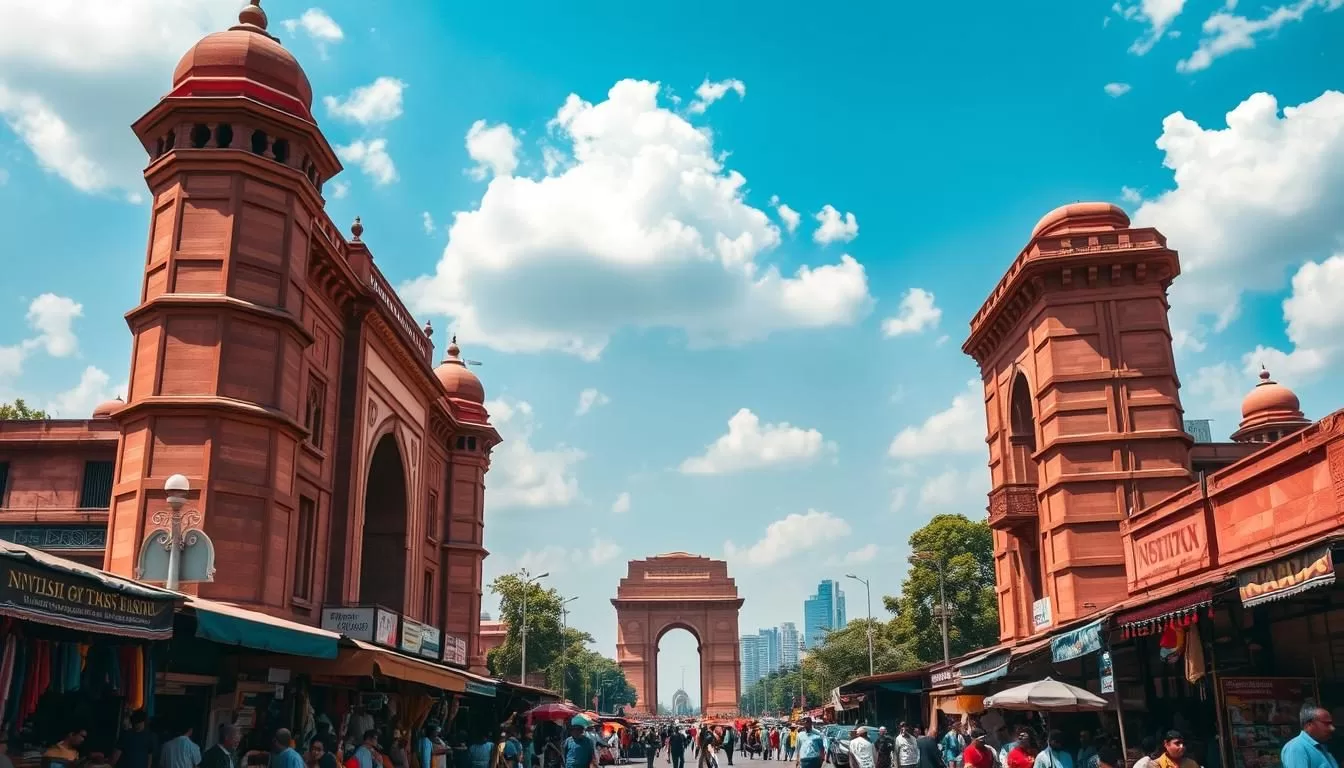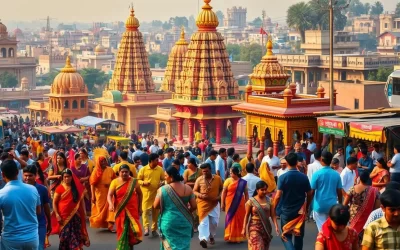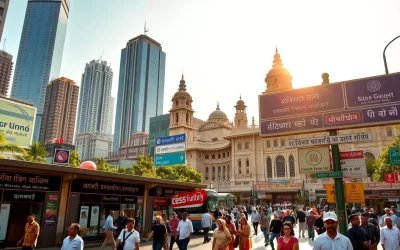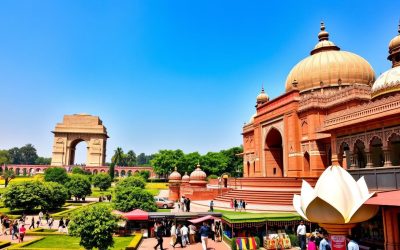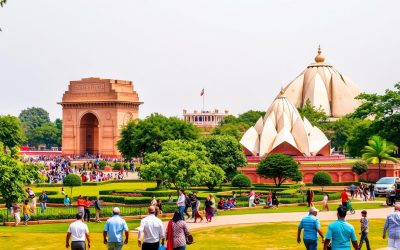Planning a trip to Delhi requires understanding its unique climate patterns, which differ significantly from other parts of India. The city’s weather varies greatly throughout the year, making timing crucial for a pleasant visit.
Delhi experiences extreme weather conditions, ranging from freezing winter fog to scorching summer heat. To make the most of your trip, it’s essential to know the best time to visit based on temperature, humidity, air quality, and seasonal events.
This comprehensive guide will help you navigate Delhi’s climate to plan your perfect weather-savvy trip. By understanding the city’s weather patterns, you can pack accordingly and maximize your sightseeing opportunities in this historically rich city.
Understanding Delhi’s Climate Patterns
Understanding the climate patterns of Delhi is crucial for travelers planning a trip. Delhi’s climate is characterized by a mix of extreme temperatures and distinct seasonal changes.
The Five Distinct Seasons of Delhi
Delhi experiences five distinct seasons: winter, spring, summer, monsoon, and post-monsoon (fall/autumn). Each season brings unique weather conditions. Winters are cold, with mild days and chilly nights, while springs are glorious with pleasant temperatures. Summers are intense and hot, with high humidity. The monsoon season transforms the weather from scorching to sticky, and post-monsoon brings relief with pleasant temperatures.
| Season | Months | Characteristics |
|---|---|---|
| Winter | December to February | Cold nights, mild days |
| Spring | Mid-February to March | Pleasant temperatures |
| Summer | April to June | Hot, humid |
| Monsoon | July to September | High rainfall, humidity |
| Post-Monsoon | October to November | Pleasant temperatures, declining air quality |
How Delhi’s Weather Differs from the Rest of India
Delhi’s inland location in North India results in a climate that differs significantly from the tropical south and the mountainous Himalayan region. Unlike coastal parts of the country, Delhi experiences extreme temperature fluctuations. The city’s weather patterns are influenced by its position in the Indo-Gangetic plain, creating distinct seasonal characteristics unlike other parts of India.
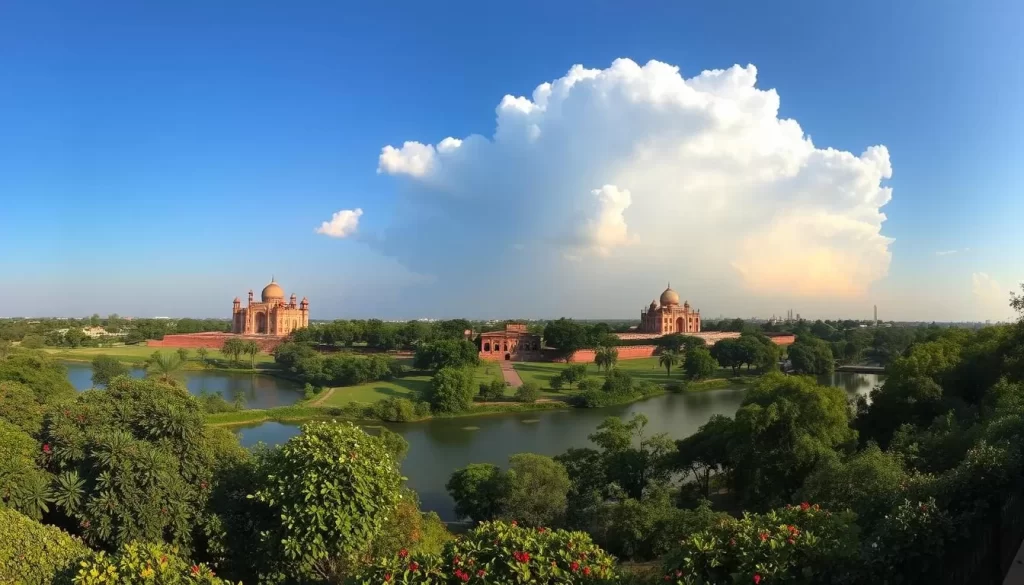
Winter in Delhi: November to February
Winter in Delhi, spanning from November to February, brings with it a mix of chilly nights and mild days. This season is a welcome respite from the sweltering heat of the previous months, making it a popular time for tourists to visit.
Temperature Ranges and What to Expect
During December and January, Delhi experiences cold nights but mild days. The overnight temperatures can drop to freezing on occasion, while the daytime temperature remains around 68 degrees Fahrenheit (20 degrees Celsius). It’s not uncommon for the temperature to reach as low as 61 degrees Fahrenheit (16 degrees Celsius) during early January.
Winter Fog and Travel Disruptions
Dense fog is a common occurrence in early January, potentially causing significant travel disruptions with flight and train delays or cancellations. You should be prepared for such eventualities when planning your trip during this time.
Winter Festivals and Events
The winter month hosts some of Delhi’s most significant festivals and events. Notable among these are India’s Republic Day Parade on January 26th, featuring the three divisions of the armed forces, and the India Art Fair, which showcases modern and contemporary South Asian art across four days at the end of January and start of February.
| Event | Date | Description |
|---|---|---|
| Republic Day Parade | January 26th | Features the three divisions of the armed forces |
| India Art Fair | Late January to early February | Showcases modern and contemporary South Asian art |
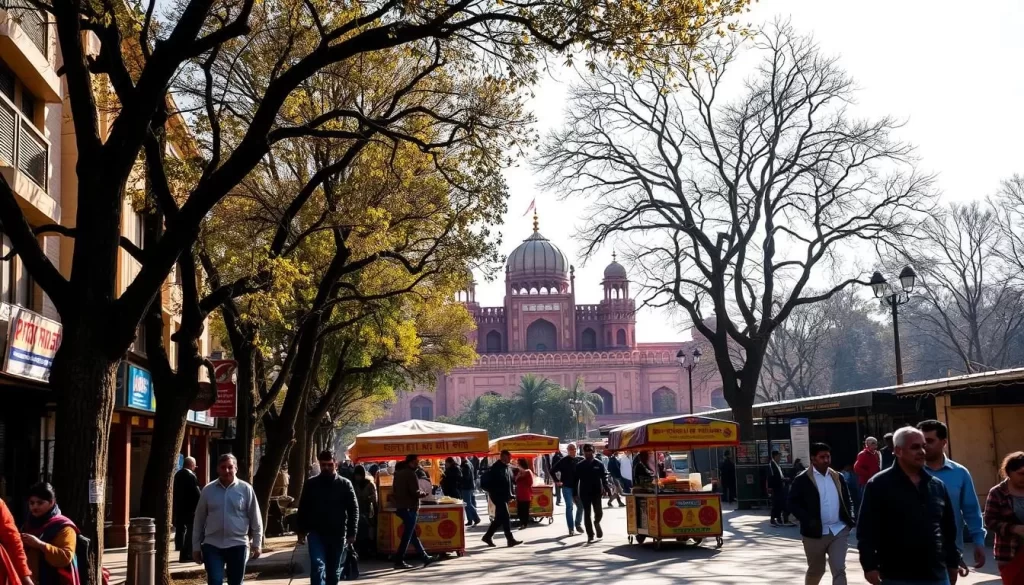
As you plan your visit to Delhi during the winter season, be aware that it is considered the peak tourist season in North India. You should expect higher accommodation rates and more crowds at popular attractions during this time of the year. However, the clear, sunny days provide ideal conditions for exploring Delhi’s numerous outdoor historical monuments and gardens. Be prepared for cold nights, and pack accordingly.
Spring in Delhi: February to March
The spring season in Delhi is a treat, with comfortable temperatures and a plethora of cultural events. As the winter chill dissipates, the city comes alive with vibrant festivals and pleasant weather, making it an excellent time to visit.
Pleasant Weather Conditions
During spring, Delhi experiences warm, sunny days and mild nights, creating ideal conditions for outdoor activities and sightseeing. Daytime temperatures gradually rise from around 75°F (24°C) in February to 91°F (35°C) by late March. You can enjoy clear skies and comfortable temperatures, avoiding both the winter chill and the extreme summer heat.
Spring Cultural Events and Activities
Spring in Delhi is not just about the weather; it’s also a time for cultural festivities. The city hosts several events, including the Udyanotsav, where the magnificent Mughal gardens at the President’s residence are open to the public. You can also experience the vibrant Holi festival, typically celebrated in March, through events like the Holi Moo music festival. Additionally, the Shiva Moon Tantra Festival offers a unique blend of meditations, tantric rituals, live music, and dance performances.
| Event | Date | Description |
|---|---|---|
| Udyanotsav | Early February to mid-March | Visit the beautiful Mughal gardens at the President’s residence |
| Holi Moo Music Festival | Typically in March | Celebrate Holi with music and festivities |
| Shiva Moon Tantra Festival | Early March | Experience meditations, tantric rituals, and live performances |

As you plan your visit, consider the rising temperatures in March and schedule your outdoor activities for early morning or evening to avoid the midday sun. With its pleasant weather and rich cultural experiences, spring is a great time to explore Delhi.
Summer Heat: April to June
From April to June, Delhi experiences its hottest season, with daytime temperatures consistently crossing 105°F (40°C). The heat is relentless, making it essential for visitors to take necessary precautions.
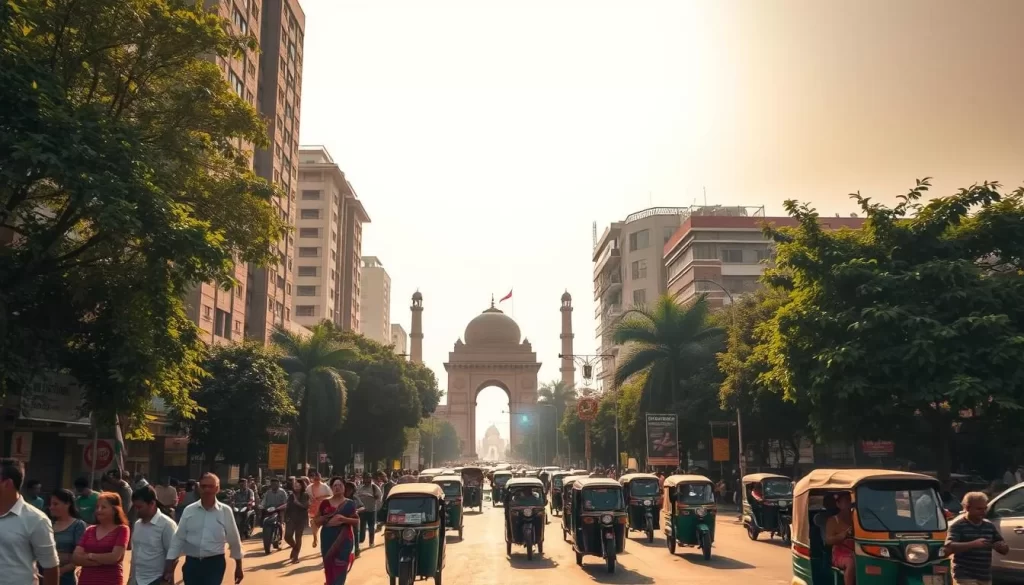
Dealing with Extreme Temperatures
To cope with the summer heat, it’s crucial to stay hydrated, wear lightweight clothing, and limit outdoor activities to early morning or evening hours. The temperatures can be challenging, but with the right precautions, you can navigate the days comfortably.
Indoor Activities During Summer Months
Delhi offers numerous indoor attractions that provide respite from the heat. You can visit world-class museums, art galleries, and shopping malls that offer air-conditioned comfort. These indoor spaces are perfect for escaping the harsh summer conditions.
Budget Travel Opportunities in Summer
Summer is considered the low season in Delhi, making it an ideal time for budget travel. You can find substantial discounts on accommodations and attractions, allowing you to explore the city without breaking the bank. Additionally, consider visiting nearby hill stations or wildlife parks for a refreshing change of scenery.
By being mindful of the summer temperatures and planning accordingly, you can have a comfortable and enjoyable trip to Delhi even during the hottest time of the year.
Monsoon Season: July to September
The southwest monsoon brings relief from the intense summer heat, but introduces a new set of challenges for travelers in Delhi. As the monsoon season sets in by the first week of July, the city’s climate transforms from scorching hot to humid and sticky.
Rainfall Patterns and Humidity Levels
During the monsoon season, Delhi experiences a distinctive rainfall pattern characterized by intense downpours that can last for several days, followed by brief dry periods. The rain doesn’t come all at once; instead, it builds up with intermittent thunderstorms over several days before culminating in heavy rainfall. Despite the rain, daytime temperatures remain high, averaging around 96°F (36°C), with little relief at night due to the high humidity levels.
- The monsoon season brings significant rainfall, transforming Delhi’s landscape and climate.
- High humidity levels persist throughout the season, making the weather feel uncomfortably hot and sticky.
- The rain typically eases off by early September, but the weather remains humid until the monsoon withdraws at the end of the month.
Navigating Delhi During the Rains
Navigating Delhi during the monsoon season requires preparation and flexibility. Sudden downpours can cause localized flooding and traffic congestion, complicating travel plans. It’s essential to stay informed about weather forecasts and plan your activities accordingly. While the rain can make sightseeing challenging, the lush greenery that follows is a beautiful contrast to the pre-monsoon dry landscape.
Traveling during the monsoon season has its advantages, including significantly reduced tourist crowds and lower accommodation rates, making it a budget-friendly time to visit Delhi. However, the combination of heat and humidity can still make sightseeing physically demanding, even on days without rain.
National Capital Territory, India: Best Months for a Weather-Savvy Trip
For a weather-savvy trip to Delhi, identifying the best months to visit is essential. The city’s climate varies significantly throughout the year, making some periods more favorable for travel than others.
October to March: The Ideal Window
The period from October to March represents the ideal window for a trip to Delhi, offering the most comfortable climate conditions throughout the year. During these months, you can expect pleasantly warm days and cool evenings, with daytime temperatures typically ranging from 68°F to 86°F (20°C to 30°C). October and November are particularly appealing, as they offer balanced conditions after the monsoon has withdrawn but before the winter chill sets in, making them perhaps the best time to visit the National Capital Territory.
This six-month window is also optimal for exploring the popular Golden Triangle circuit that connects Delhi with Agra and Jaipur. If you’re planning to combine your Delhi visit with other parts of North India or the Golden Triangle, the October to March window works well for most destinations in the region.
| Month | Temperature Range | Advantages |
|---|---|---|
| October | 75°F – 86°F (24°C – 30°C) | Post-monsoon greenery |
| November | 68°F – 79°F (20°C – 26°C) | Comfortable weather, festivals |
| December | 55°F – 70°F (13°C – 21°C) | Clear skies, peak tourist season |
| January | 45°F – 65°F (7°C – 18°C) | Cooler weather, potential fog |
| February | 50°F – 75°F (10°C – 24°C) | Clear days, fewer tourists than December |
| March | 65°F – 85°F (18°C – 30°C) | Spring blooms, comfortable temperatures |
Shoulder Seasons: Value vs. Comfort
The shoulder months of February-March and October-November offer an excellent balance of comfortable weather and better value, with fewer tourists than the peak winter months. December and January represent the peak tourist season, with the highest visitor numbers and accommodation rates, particularly around the Christmas and New Year holidays.
Each month within the October to March window offers different advantages, from post-monsoon greenery in October to spring blooms in March. Year-round travelers should note that while October to March is generally considered the best time to visit Delhi, each month has its own character and considerations that might influence your specific travel plans.
Special Considerations for Delhi Visitors
Delhi, being one of the most populous cities in the world, presents unique challenges for visitors, including air pollution and crowds. As you plan your trip, it’s essential to be aware of these factors to make the most of your visit.
Air Pollution Concerns: October to January
Air pollution is a significant concern in Delhi, particularly from October to January, when hazardous smog blankets the city. The air quality is typically worst in November, especially after the Diwali festival when fireworks exacerbate the already poor conditions. To protect your health, consider bringing a proper anti-pollution mask (N95 or equivalent) if you have respiratory conditions like asthma or bronchitis.
The weather patterns during winter months trap pollutants close to the ground, creating a persistent haze that can impact visibility at tourist attractions and potentially affect your health. You should check the air quality index daily and plan your activities accordingly.
| Month | Air Quality Index | Precautions |
|---|---|---|
| October | Moderate to Unhealthy | Wear a mask on poor air quality days |
| November | Very Unhealthy | Avoid outdoor activities, use a mask |
| December | Unhealthy to Very Unhealthy | Limit outdoor exposure, use air purifiers |
| January | Unhealthy | Monitor air quality, plan indoor activities |
Crowd Levels at Tourist Attractions
Crowd management is another crucial consideration when planning your Delhi itinerary. As a major metropolitan area, Delhi is one of the most densely populated cities on earth, making it crowded at any time of the year. You’ll encounter the highest crowd levels during the peak winter season (December-January), especially around major holidays and at popular Golden Triangle attractions.
To avoid the crowds, consider visiting major monuments and museums early in the morning or later in the evening. Weekends, particularly Sundays, see significantly higher visitor numbers as locals enjoy their time off with family. Strategic timing of your visits can dramatically improve your experience.
By being mindful of these factors, you can better plan your time visit to Delhi and enjoy a more pleasant experience. Whether you’re exploring the tourist attractions or simply navigating the city, being prepared for the crowds and air quality will make your trip more enjoyable.
Conclusion: Planning Your Perfect Delhi Trip
With its diverse climate and plethora of cultural events, planning a trip to Delhi requires careful consideration of several factors. The best time to visit Delhi is during the cooler, dry months from October to March, offering a comfortable experience for exploring the city’s historical and cultural treasures.
However, it’s crucial to be aware of the severe air pollution that can affect this period. On the other hand, timing your trip to Delhi to coincide with one of its vibrant festivals, such as Diwali or Holi, can enhance your experience with unique cultural insights.
When planning your visit to India, particularly as part of the Golden Triangle circuit, Delhi serves as an excellent starting point before heading to Agra and Jaipur. This guide has provided you with season-by-season insights to help make an informed decision about the best time for your Delhi adventure.
Your perfect Delhi trip might look different depending on your interests—whether you’re a history buff, a budget traveler, or someone looking to immerse in cultural events. Proper preparation regarding clothing, hydration, and health precautions will ensure a more enjoyable experience, regardless of when you choose to visit India.
By balancing weather considerations with your tolerance for crowds and interest in festivals, you can create a memorable and enriching experience in this vibrant city.
The above is subject to change.
Check back often to TRAVEL.COM for the latest travel tips and deals.
